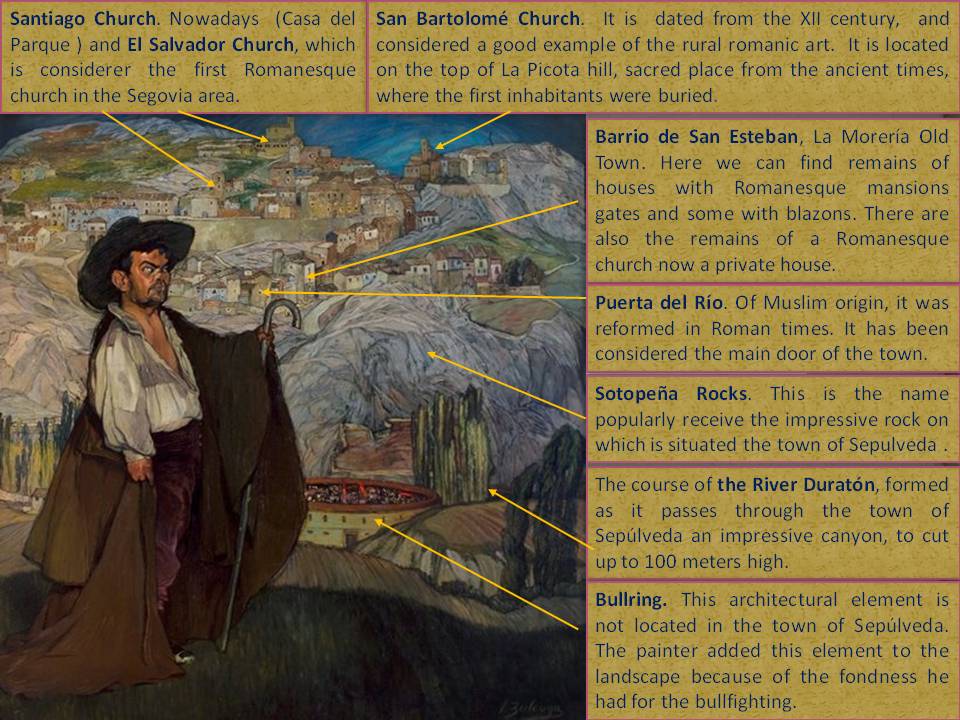SEPÚLVEDA (Ignacio Zuloaga, 1908)
This work of art was created by the Basque painter Ignacio Zuloaga, and is entitled The dwarf Gregory Botero, in Sepúlveda. In this picture we can appreciate how the landscape and the city are as important as the character in the foreground.
Sepúlveda is a town situated in the northeast of Segovia province, it is perched on a hill between the rivers Duratón and Caslilla. In 1951, Sepúlveda was declared a historic- artistic site to protect their cultural values. Despite the fact that we cannot see in the picture all the treasures that the town offers, it shows us an example of its art and privileged location at the entrance of the River Duratón Natural Park.
Strolling through the streets of Sepúlveda is like being immersed in the history of Castile. In its narrow steep streets and irregular layout, we can discover places full of art with emblazoned mansions in every corner and its well-preserved Romanesque style architecture. The labyrinthine layout and the division of the city in different areas (Jewish, Muslim and Christian), is a common structure of the city in the Middle Ages and Muslim cities of that period. From the first moment you will feel like you are in an authentic medieval city.
Sepúlveda is also known as the city of the seven keys or the seven gates. The reason is because on the Middle Ages the city was fortified, and the access to the city was only possible through one of those guarded gates. The city of Sepúlveda was build at the top of a hill surrounded by city walls and the Duratón River for defense facilities, what is a typical Medieval city construction. This city wall and the gates were built by the Muslims in the 10th century, and nowadays some sections are still in very good conditions. The most important gate is the Río Gate, which is considered the main access to the city.
The name Sepúlveda is linked to the Reconquest of Castile by the Christians. The city was for a long time in a frontier zone where instability was continuous for its inhabitants, and the conquests of the city by the Moors and Christians were frequent. Therefore, in 1076, King Alfonso VI granted the city with a privilege law which gave the dwellers some liberties and favours to encourage people to continue living in such hostile land.
The Christian dwellers brought rich Romanesque art that still remains in the town of Sepúlveda, and we can find churches like San Bartolomé, which is situated in the highest point of the fortified enclosure, in front of the space that now is occupied by the main Square. Another important church is El Salvador, which is one of the most important jewels of the Castilian Romanesque, because it is dated in 1093, which means that is probably the oldest Romanesque church in Segovia. The third impressive church we can find in the north of the town is called Nuestra Señora de la Peña, which is known for the magnificent sculpture we can find in the tympanum of its doorway.
In Sepúlveda we can find many other monuments that have in our days a civil use, such as the Romanesque Santiago Church, which has been repair and now is the House of the Park (Natural Park Hoces of the Duratón River Interpretation Centre). Inside the town, very close to the Ecce Homo gate, there is the Santos Justo y Pastor Church, which is now the Fueros Museum, where we can find all the information about art and history in the town.
In the centre of the city we can find the Main Square with rectangular form and the ruins of one antique castle. Since the Middle age, this has been the location of the main market, and in here also the city has celebrated bullfighting festivals. Now, we can still finding here business but there are focused in the tourism. Today Sepúlveda cannot be considered as a city, it is a rural town but one of the most important in Segovia. The main industry in the town, but the agriculture, is the tourism. It receives a number of visitors who come to see their monuments and views and enjoy its gastronomic pleasures.
Natalia del Pozo Bayón

